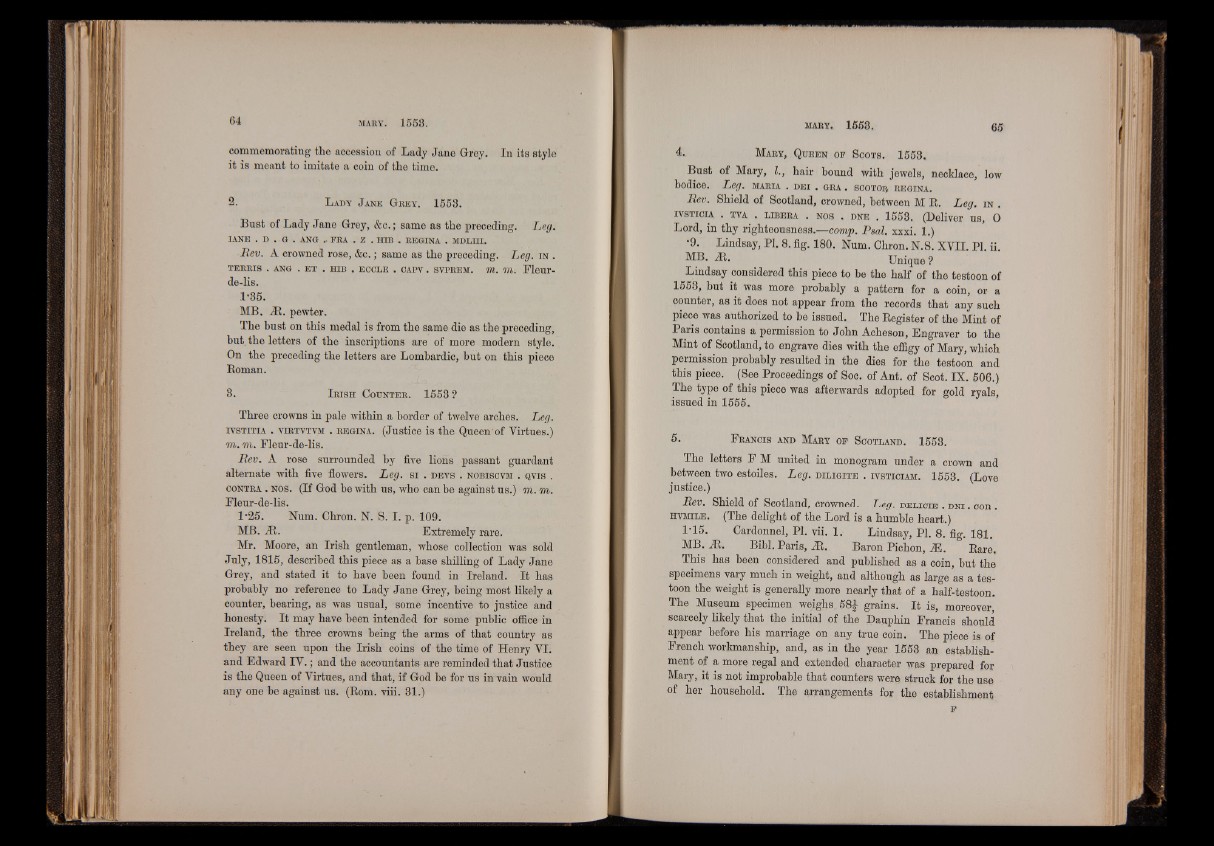
commemorating the accession of Lady Jane Grey. In its style
it is meant to imitate a coin of the time.
2. L ady J ane G r e y . 1558.
Bust of Lady Jane Grey, &c.; same as the preceding. Leg.
IANE . D . G . ANG FRA . Z . HIB . REGINA . MDLIII.
Iiev. A crowned rose, &c.; same as the preceding. Leg. in .
TERRIS . ANG . ET . HIB . EOOLE . CAPV . SVPREM. TO. TO. Fleur-
de-lis.
1-85.
MB. At. pewter.
The bust on this medal is from the same die as the preceding,
but, the letters of the inscriptions are of more modern style.
On the preceding the letters are Lombardic, but on this piece
Boman.
8. I r is h C o u n t e r . 1553?
Three crowns in pale within a border of twelve arches. Leg.
ivsT iTiA . vtrtvtvm . r e g in a . (Justice is the Queen'of Virtues.)
to. to. Fleur-de-lis.
Rev. A rose surrounded by five lions passant guardant
alternate with five flowers. Leg. si . d ev s . nobiscvm . qvis .
contra . n o s . (If God be with us, who can be against us.) to. to.
Fleur-de-lis.
l -25. Num. Chron. N. S. I. p. 109.
MB. At. Extremely rare.
Mr. Moore, an Irish gentleman, whose collection was sold
July, 1815, described this piece as a base shilling of Lady Jane
Grey, and stated it to have been found in Ireland. It has
probably no reference to Lady Jane Grey, being most likely a
counter, bearing, as was usual, some incentive to justice and
honesty. It may have been intended for some public office in
Ireland, the three crowns being the arms of that country as
they are seen upon the Irish coins of the time of Henry VI.
and Edward IV .; and the accountants are reminded that Justice
is the Queen of Virtues, and that, if God be for us in vain would
any one be against us. (Rom. viii. 31.)
4. Mary, Queen of Scots. 1558,
Bust of Mary, I., hair bound with jewels, necklace, low
bodice. Leg. maria . d e i . gra . scotor r e g in a .
Rev. Shield of Scotland, crowned, between M R. Leg. in .
iv s t io ia . TVA , l ib e r a . nos . d n e . 1553. (Deliver us, O
Lord, in thy righteousness.—comp. Peal. xxxi. 1.)
•9. Lindsay, PI. 8. fig. 180. Num. Chron. N.S. XVII. PI. ii.
MB. At. Unique ?
Lindsay considered this piece to be the half of the testoon of
1558, but it was more probably a pattern for a coin, or a
counter, as it does not appear from the records that any such
piece was authorized to be issued. The Register of the Mint of
Paris contains a permission to John Acheson, Engraver to the
Mint of Scotland, to engrave dies with the effigy of Mary, which
permission probably resulted in the dies for the testoon and
this piece. (See Proceedings of Soc. of Ant. of Scot. IX. 506.)
The type of this piece was afterwards adopted for gold ryals,
issued in 1555.
5. F ra nc is and M ary o f S cotland . 1553.
The letters F M united in monogram under a crown and
between two estoiles. Leg. d il ig it e . iv s t ic ia m . 1553. (Love
justice.)
Rev. Shield of Scotland, crowned. Leg. d e l ic ie . d n i . cor .
h v m il e . (The delight of the Lord is a humble heart.)
1-15. Cardonnel, PI. vii. 1. Lindsay, PI. 8. fig. 181.
MB. At. Bibl. Paris, At. Baron Pichon, Æ. Rare.
This has been considered and published as a coin, but the
specimens vary much in weight, and although as large as a testoon
the weight is generally more nearly that of a half-testoon.
The Museum specimen weighs 581 grains. It is, moreover,
scarcely likely that the initial of the Dauphin Francis should
appear before his marriage on any true coin. The piece is of
French workmanship, and, as in the year 1553 an establishment
of a more regal and extended character was prepared for
Mary, it is not improbable that counters were struck for the use
of her household. The arrangements for the establishment
F